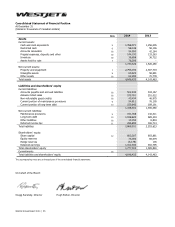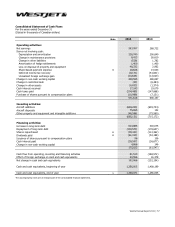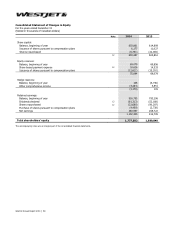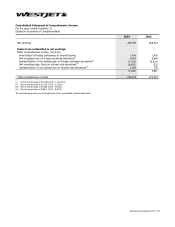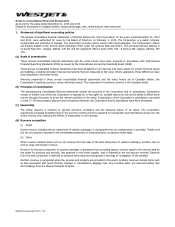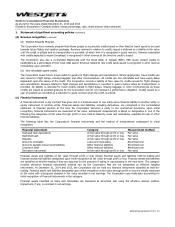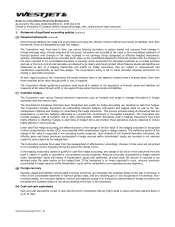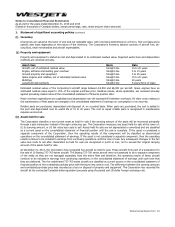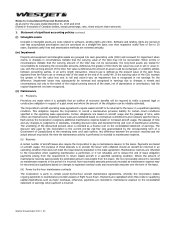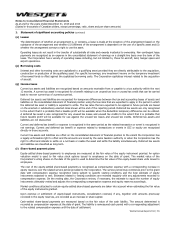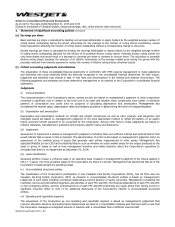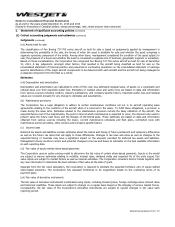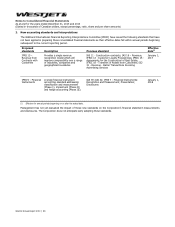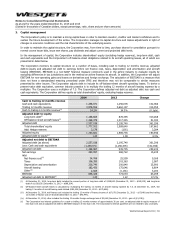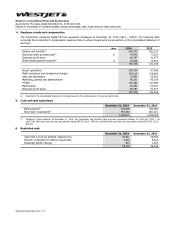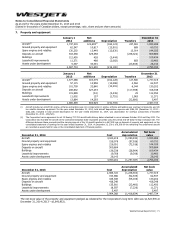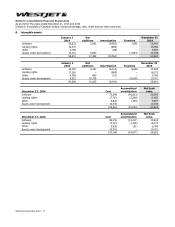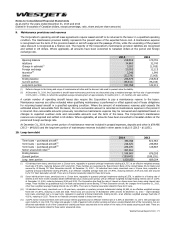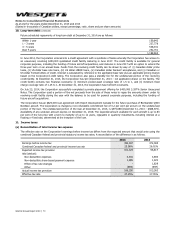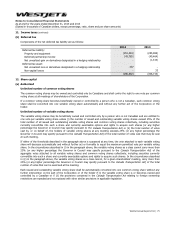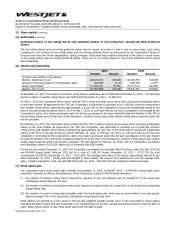Westjet 2014 Annual Report Download - page 68
Download and view the complete annual report
Please find page 68 of the 2014 Westjet annual report below. You can navigate through the pages in the report by either clicking on the pages listed below, or by using the keyword search tool below to find specific information within the annual report.
Notes to Consolidated Financial Statements
As at and for the years ended December 31, 2014 and 2013
(Stated in thousands of Canadian dollars, except percentage, ratio, share and per share amounts)
WestJet Annual Report 2014 │ 66
1. Statement of significant accounting policies (continued)
(s) Earnings per share
Basic earnings per share is calculated by dividing net earnings attributable to equity holders by the weighted average number of
voting shares outstanding during the period, accounting for any changes to the number of voting shares outstanding, except
those transactions affecting the number of voting shares outstanding without a corresponding change in resources.
Diluted earnings per share is calculated by dividing net earnings attributable to equity holders by the weighted average number
of voting shares outstanding adjusted for the effects of all potential dilutive voting shares. Potential dilutive voting shares are
only those shares that would result in a decrease to earnings per share or increase to loss per share. The calculation of potential
dilutive voting shares assumes the exercise of all dilutive instruments at the average market price during the period with the
proceeds received from exercise assumed to reduce the number of dilutive voting shares otherwise issued.
(t) Critical accounting judgments and estimates
The preparation of these consolidated financial statements in conformity with IFRS requires management to make judgments
and estimates that could materially affect the amounts recognized in the consolidated financial statements. By their nature,
judgments and estimates may change in light of new facts and circumstances in the internal and external environment. The
following judgments and estimates are those deemed by management to be material to the Corporation’s consolidated financial
statements.
Judgments
(i) Componentization
The componentization of the Corporation’s assets, namely aircraft, are based on management’s judgment of what components
constitute a significant cost in relation to the total cost of an asset and whether these components have similar or dissimilar
patterns of consumption and useful lives for purposes of calculating depreciation and amortization. Management has
considered the market value, depreciation rates and industry practices in determining the level of componentization.
(ii) Depreciation and amortization
Depreciation and amortization methods for aircraft and related components as well as other property and equipment and
intangible assets are based on management’s judgment of the most appropriate method to reflect the pattern of an asset’s
future economic benefit expected to be consumed by the Corporation. Among other factors, these judgments are based on
industry standards, manufacturers’ guidelines and company-specific history and experience.
(iii) Impairment
Assessment of impairment is based on management’s judgment of whether there are sufficient internal and external factors that
would indicate that an asset or CGU is impaired. The determination of a CGU is also based on management’s judgment and is an
assessment of the smallest group of assets that generate cash inflows independently of other assets. Management has
assessed WestJet as one CGU and considered factors such as whether an active market exists for the output produced by the
asset or group of assets as well as how management monitors and makes decisions about the Corporation’s operations to
conclude that there is no impairment at December 31, 2014.
(iv) Lease classification
Assessing whether a lease is a finance lease or an operating lease is based on management’s judgment of the criteria applied in
IAS 17 – Leases. The most prevalent leases of the Corporation are those for aircraft. Management has determined that all of the
Corporation’s leased aircraft are operating leases.
(v) Unconsolidated structured entities
The classification of the Corporation’s participation in nine Canadian Fuel Facility Corporations (FFCs), two US FFCs and one
Canadian De-Icing Facility Corporation (DFC) as interests in unconsolidated structured entities is based on management’s
judgement of each entity including contractual relationships and the absence of equity ownership. Management considered the
restricted, narrow and well-defined objectives and activities of each FFC and DFC, the financial dependence of each FFC and DFC
on the contracting airlines, and the contractual terms of each FFC and DFC preventing any single airline from having control or
significant influence. Refer to note 17 for additional disclosures of the Corporation’s interest in unconsolidated structured
entities.
(vi) Operating and reportable segments
The assessment of the Corporation as one operating and reportable segment is based on management’s judgement that
resource allocation decisions and performance assessments are done at a consolidated company and fleet level with a view that
the Corporation manages an integrated network of markets with a consolidated fleet of different sized aircraft.


